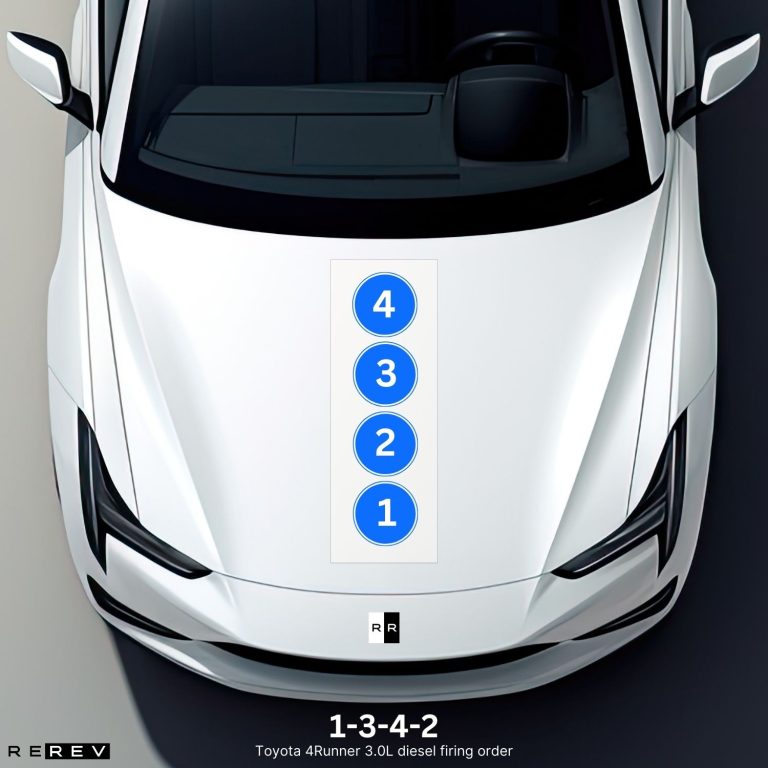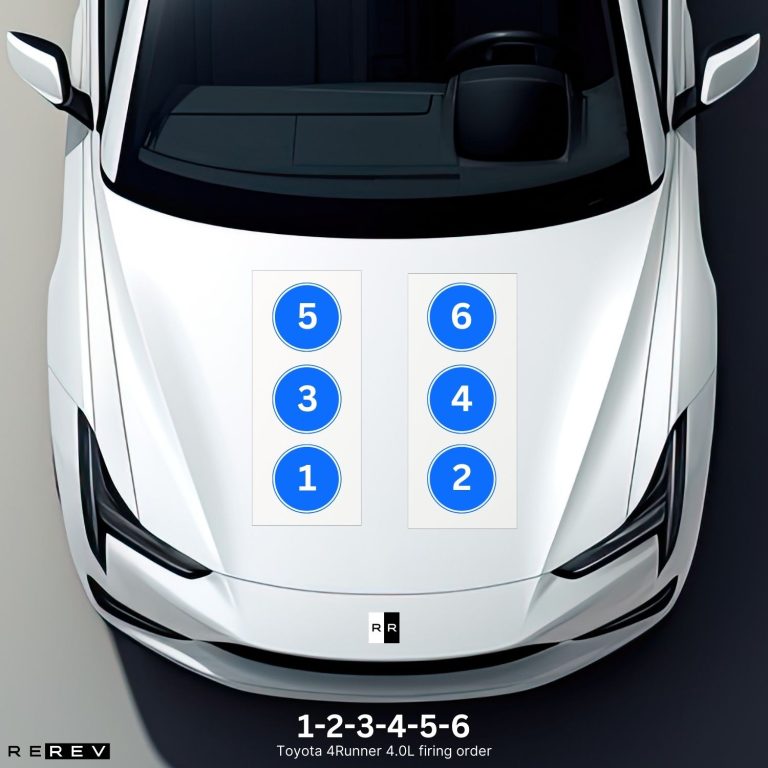Toyota 4Runner (1995-2023) firing order — diagram & guide

As one of the most popular mid-size SUVs on the US market, the Toyota 4Runner has always been considered one of the most reliable options in this vehicle category. It’s mostly due to exceptional engines used by Toyota that could pass hundreds of thousands of miles.
Still, if you happen to own one of these and experience some minor engine issues, a Toyota 4Runner (1995-2023) firing order can help you deal with them yourself. Since the order can be different for all types of engines used throughout the years, our team thought we’d give you a complete guide for all of them.
| 4RUNNER YEARS | ENGINE | FIRING ORDER |
|---|---|---|
| 3rd Gen (1995-2001) | 2.7L | 1-3-4-2 |
| 3.4L V6 | 1-2-3-4-5-6 | |
| 3.0L Diesel | 1-3-4-2 | |
| 4th Gen (2002-2008) | 2.7L | 1-3-4-2 |
| 4.0L V6 | 1-2-3-4-5-6 | |
| 4.7L V8 | 1-8-4-3-6-5-7-2 | |
| 3.4L V6 | 1-2-3-4-5-6 | |
| 5th Gen (2009-2023) | 2.7L | 1-3-4-2 |
| 4.0L | 1-2-3-4-5-6 |
Third-generation Toyota 4Runner (1995-2001) firing order
For a mid-size SUV of that time, the third-gen Toyota 4Runner offered some pretty remarkable engine options perfect for towing. There was a four-cylinder petrol engine along with a V6 and a four-cylinder turbodiesel, so we’ll take a closer look at each below.
Toyota 4Runner 2.7L firing order

The Toyota 4Runner 2.7L firing order is 1-3-4-2 and this firing pattern is pretty common for Toyota’s four-cylinder engines. However, it’s important to differentiate between the diesel and the petrol engine, and this one also has a different cylinder order.
Most notably, the first cylinder of the 2.7-liter engine is located on the left side, and cylinders go from 1 to 4 in a straight line from left to right.
Toyota 4Runner 3.4L firing order

While the 2.7-liter was a base engine option for this generation of the 4Runner, the 3.4-liter was used in higher-spec trims. The Toyota 4Runner 3.4L firing order is 1-2-3-4-5-6, and this firing order is also pretty common among Toyota’s V6s of that time.
Even so, the cylinder layout is pretty specific to this engine, since it’s a transversely-placed V6. That means that odd cylinder numbers go 1, 3, and 5 from left to right in the upper bank. The even cylinder numbers 2, 4, and 6 are located right below these.
Toyota 4Runner 3.0L diesel firing order

As a final option and a short-lived engine available only in just a few model years of the 4Runner, Toyota also offered a 3.0-liter diesel engine. However, this one wasn’t like the petrol 3.0-liter since it’s a four-cylinder engine with a firing order of 1-3-4-2.
On top of that, it’s also unlike the petrol four-cylinder counterpart since the cylinders are arranged from the first one at the front of the engine, to the fourth one at the rear end.
Fourth-generation Toyota 4Runner (2002-2008) firing order
Now we come to the fourth-gen 4Runner model and this one features some of the same engine options as the previous one. However, besides the old 3.4-liter V6 and a 2.7-liter four-cylinder, there’s also the addition of two extra engine options we’ll discuss.
Toyota 4Runner 4.0L firing order

The firing order for Toyota 4Runner 4.0L is 1-2-3-4-5-6 and this engine is a longitudinal V6 with a rather specific cylinder layout. The first cylinder can be found on the passenger’s side along with cylinders 3 and 5, front to rear.
Another cylinder bank is on the driver’s side and this one mostly carries even cylinder numbers 2, 4, and 6, also front to rear.
Toyota 4Runner 4.7L firing order

As the only version of this model equipped with a V8 engine, the Toyota 4Runner 4.7L firing order is 1-8-4-3-6-5-7-2. As a V8, this engine has two cylinder banks and the first cylinder is located within the driver’s side cylinder bank, along with cylinders 3, 5, and 7.
On the other hand, we’ve got the cylinders 2, 4, 6, and 8 laid out in that order front to rear, so it’s easy to do the cylinder numbering regardless of the V8 layout.
Fifth-generation Toyota 4Runner (2009-2023) firing order
Finally, we come to the most recent generation of the 4Runner and this one was once again based on some engine options that were used by the previous model years. So, Toyota decided to bring back the 2.7-liter four-cylinder and keep the 4.0-liter V6 from the previous generation.
We’ve already addressed these two and the firing order for the 2.7-liter 4Runner is 1-3-4-2, while the firing order for the 4.0L V6 is 1-2-3-4-5-6.
Our take
Well, that concludes our guide on the Toyota 4Runner firing order, and hopefully, that along with our detailed description of cylinder layout can help you keep your 4Runner, well, running longer.
Remember that it’s crucial to use the firing order accordingly so you have to be sure which cylinder is in which position for this to work, and we believe you’ll be able to diagnose misfires and change faulty plugs in no time.